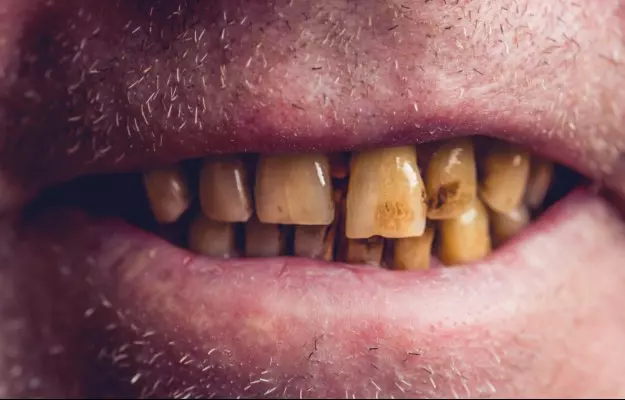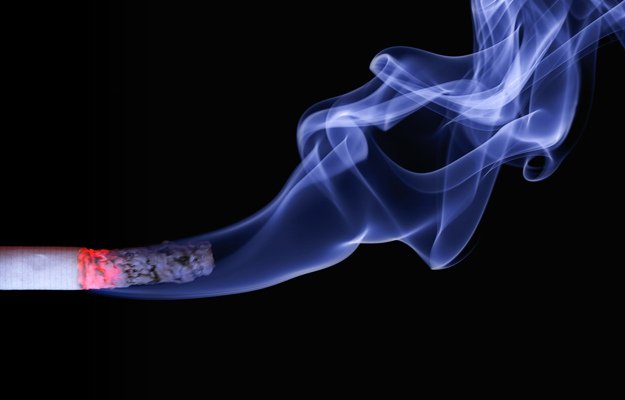Ever heard that smoking tobacco can make your lips dark, stain your teeth and cause your gums to recede? This is just the tip of the iceberg. Smoking affects the teeth, gums, and mouth in multiple ways.
Regular smoking can not only cause minor dental problems like staining of teeth, bad breath and gum diseases but can also lead to life-threatening conditions like oral cancer. Smoking regularly can also cause lesions in the mouth, dry mouth, cavities, bleeding gums, and in rare cases, pus formation in the gums.
In India, cigarette packets are covered with a graphic warning that says "smoking kills". Despite this, 99.5 million Indians smoke tobacco, according to WHO's "Global Adult Tobacco Survey-2018 of India" (GATS 2018). The prevalence of smoking in India is 19% in men and 2% among women.
Smoking affects every aspect of health. A study conducted at the University in Bristol, UK, found that just one cigarette a day can reduce 11 minutes from the smoker's life. Add to this the fact that chain smokers can go through a whole packet of cigarettes or bidis a day, and you have a surefire recipe for ill-health. Some chain smokers also end up spending half of their earnings on bidis and cigarettes, etc., which can take a further toll on their quality of life and overall well-being.
Tobacco smoking is done in various forms such as bidis, cigarettes, cigars, pipes, chillums, hookahs, e-cigarettes and vapes.
- Effects of smoking on teeth
- Smoking effects on gums and roof of the mouth
- Side-effects of smoking on the tongue
- Smoking effects on cheeks
- How does smoking affect breath?
- Oral cancer
- Takeaway for side-effects of smoking for the mouth
Effects of smoking on teeth
Smoking affects the teeth in many ways. Chief among them are:
- Stained teeth: Staining of teeth is very common in people who smoke on a regular basis. The tar of the cigarette covers the upper surface of the teeth with a yellowish-brown layer. Initially, the layer is light yellow in colour which darkens to brown, dark brown and even black with time. In the case of chain smokers, due to excessive smoking, the tar of the cigarette seeps into the micropores of the enamel (the superficial layer of the tooth). Once this happens, the teeth become permanently discoloured.
- Cavities: The saliva in the mouth helps in keeping the upper surface of the teeth moist. It also flushes or removes any food particles stuck on the surface of the teeth or in-between two teeth. Thus, the proper flow of saliva helps in preventing the attack of cavities (dental caries) causing bacteria, Streptococcus mutans.
- Loose teeth: Smoking promotes the buildup of calculus on the surface of the teeth which leads to weakening of gums and degradation of the underlying bone. Calculus is a thick layer - worse than plaque - that forms on the teeth of those who smoke and don't brush properly.
Nicotine also changes the cell structure of fibroblasts (collagen forming cells) which makes the attachment of gums weak, thus, the teeth become loose and more prone to fall off easily.
Read more: Techniques of brushing
Smoking effects on gums and roof of the mouth
The effects of smoking on the gums and the roof of the mouth (palate) are:
- Periodontitis: Smoking promotes the buildup of plaque and calculus (hard tartar) in the teeth. The excessive plaque and tartar start getting collected under the gum line which causes inflammation of the gums known as gingivitis. Gingivitis is a reversible stage and can be managed by brushing and cleaning.
If gingivitis is not managed, the inflammation of the gums increases and leads to severe irreversible damage like loss of bone and the periodontal ligament (the ligament that helps in holding the teeth in place). This stage is medically known as periodontitis where the patient suffers from bleeding gums, bad breath and loose teeth. - Necrotising ulcerative gingivitis: Smoking encourages the growth of microbes in the mouth such as Porphyromonas gingivalis, Prevotella intermedia, and Aggregatibacter actinomycetemcomitans which causes oral (mouth) diseases like necrotising ulcerative gingivitis (NUG), aggressive periodontitis among other conditions.
NUG is a specific kind of periodontal disease in which the symptoms appear rapidly such as decaying of the gums between two teeth, toothache and bleeding in the gums and foul-smelling breath. - Smoker’s melanosis: Smoker’s melanosis is the classic sign that can be seen in every chronic smoker. There is a visible black-brown pigmentation in the lips, palate (roof of the mouth) and gums of chronic smokers. The nicotine and tar of the smoke increase the melanin pigmentation of the gums, lips and palate making them dark.
- Dry mouth: Long-term smoking reduces the flow of the saliva and makes the mouth dry. Smoking also thickens the saliva, making it difficult to flow over the surface of the teeth. This makes a smoker more prone to cavities.
Side-effects of smoking on the tongue
Various ill-effects of smoking have been seen in the different parts of the tongue. These include:
- Reduced ability to taste: We have taste buds on our tongues that help us to differentiate between flavours. In the case of chronic smokers, the structure of the fungiform papillae (finger-like projections on the upper surface of the tongue) changes, thus hampering the taste buds. Smokers sometimes suffer from loss of taste sensations.
- Median rhomboid glossitis: Median rhomboid glossitis is a reddish inflammatory lesion on the back of the upper surface of the tongue. Smoking is one of the reasons behind the loss of lingual papillae (normally present on the upper surface of the tongue) which causes median rhomboid glossitis.
- Oral candidiasis: Smoking thickens the saliva, which creates an ambient environment for the growth of bacteria and fungi. Oral candidiasis (a type of thrush) is a fungal infection caused by Candida albicans, which presents as white leathery patches on the lateral borders (sides) of the tongue. Smoking promotes the growth of Candida albicans. It can make your breath smell foul.
Read more: White Coated Tongues: Symptoms, Causes, Prevention, Risk Factors, Diagnosis, Treatment.
- Hairy tongue: Hairy tongue appears as black, hairlike projections on the top of the tongue. Generally, the papillae of the tongue degenerate and regrow in a certain period of time. In the case of a hairy tongue, there is either an overgrowth of the normal tongue papillae or a decrease in the rate of papillae removal. Due to the tar of smoking, the overgrown papillae of the tongue trap pigment from the tobacco and take on a black appearance. It is not painful but can lead to bad mouth odour.
Smoking effects on cheeks
Smoking leads to the formation of white patches on the skin of the cheeks. These patches can sometimes be a sign of a precancerous lesion. Other effects of smoking on the cheeks are:
- Leukoplakia: Leukoplakia is seen as a white patch on the mucosal layer (inside skin) of the cheeks. This is the second most common oral lesion found in smokers. It can sometimes present as an irregular white patch with red spots on it - this type of leukoplakia is medically called erythroplakia. It is different from the white patches of oral candidiasis as it has the potential to turn into cancer. This precancerous stage can be reversed to a normal healthy one if diagnosed early.
- Leukoedema: Leukoedema can look like precancerous lesions, but it is only a variation in the skin seen in chronic smokers. The mucosa (inner skin) of the cheeks has a smooth greyish film on it which disappears when the cheek is stretched (from the inside) and reappears when relaxed. It does not turn into cancer.
Read more: Smoking Addiction: Signs, Causes, Prevention, Diagnosis, Treatment
How does smoking affect breath?
People who smoke on a regular basis tend to have really foul-smelling breath which is medically known as halitosis. Tobacco products not only leave their odour in the mouth of a smoker but also make their mouths dry and more prone to gum diseases like necrotising ulcerative gingivitis. This adds to the bad breath in smokers.
Read more: Ayurvedic remedies for bad breath
Oral cancer
According to the Global Adult Tobacco Survey 2018 in India, almost one million people die of oral cancer in India every year. Oral cancer is the third most commonly occurring cancer in India. Oral cancer is the most commonly occurring cancer in men in India.
Cancer which occurs anywhere in the oral cavity, starting from the lips extending to the tonsils and the oropharynx (part of the throat connected to the mouth - oropharyngeal cancer) is known as oral cancer.
Squamous cell carcinoma (SCC) is the most commonly seen cancer in the Indian population. SCC can either appear as a thick, rough, scaly patch or a firm, pink, scaly and crusty lump which would bleed on scraping.
Tobacco smoke from bidis, cigarettes, cigars, or pipes can cause cancers anywhere in the mouth or even in the throat (throat cancer). Tobacco smoke is also responsible for the cancers of the voice box (larynx), food pipe (oesophagus), lung cancer and cancer of many other organs. Pipe smokers are more prone to get cancer of the part of the lip that touches the pipe.
Read more: Therapies for Cancer Treatment
Takeaway for side-effects of smoking for the mouth
Smoking might calm your mind for a short period of time but can create havoc in your life in the longer run. Early detection of many of these lesions can help in saving a person from oral cancer. Cessation of smoking and regular dental check-ups can help you control the damage done by smoking.
Read more: How to quit smoking
Doctors for Smoking Effects on Teeth, Gums and Oral Health

Dr.Amar Sankar Pal
Dentistry
3 Years of Experience

Dr. Swapnil Pathak
Dentistry
8 Years of Experience

Dr. Harsh Tiwari
Dentistry
7 Years of Experience














